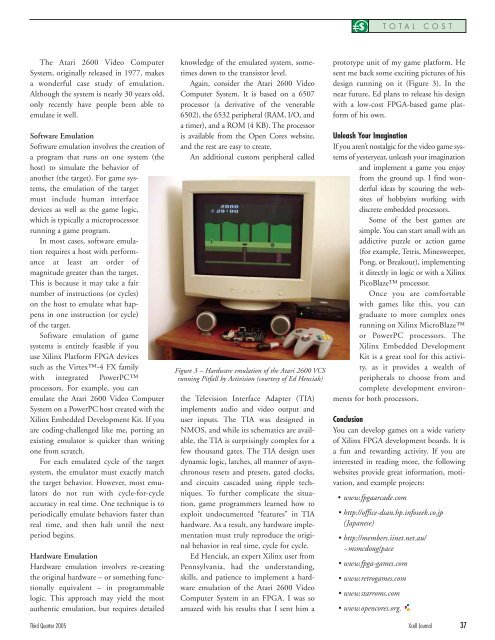Design Challenges: Avoiding the Pitfalls, winning the game - Xilinx
Design Challenges: Avoiding the Pitfalls, winning the game - Xilinx
Design Challenges: Avoiding the Pitfalls, winning the game - Xilinx
You also want an ePaper? Increase the reach of your titles
YUMPU automatically turns print PDFs into web optimized ePapers that Google loves.
The Atari 2600 Video Computer<br />
System, originally released in 1977, makes<br />
a wonderful case study of emulation.<br />
Although <strong>the</strong> system is nearly 30 years old,<br />
only recently have people been able to<br />
emulate it well.<br />
Software Emulation<br />
Software emulation involves <strong>the</strong> creation of<br />
a program that runs on one system (<strong>the</strong><br />
host) to simulate <strong>the</strong> behavior of<br />
ano<strong>the</strong>r (<strong>the</strong> target). For <strong>game</strong> systems,<br />
<strong>the</strong> emulation of <strong>the</strong> target<br />
must include human interface<br />
devices as well as <strong>the</strong> <strong>game</strong> logic,<br />
which is typically a microprocessor<br />
running a <strong>game</strong> program.<br />
In most cases, software emulation<br />
requires a host with performance<br />
at least an order of<br />
magnitude greater than <strong>the</strong> target.<br />
This is because it may take a fair<br />
number of instructions (or cycles)<br />
on <strong>the</strong> host to emulate what happens<br />
in one instruction (or cycle)<br />
of <strong>the</strong> target.<br />
Software emulation of <strong>game</strong><br />
systems is entirely feasible if you<br />
use <strong>Xilinx</strong> Platform FPGA devices<br />
such as <strong>the</strong> Virtex-4 FX family<br />
with integrated PowerPC<br />
processors. For example, you can<br />
emulate <strong>the</strong> Atari 2600 Video Computer<br />
System on a PowerPC host created with <strong>the</strong><br />
<strong>Xilinx</strong> Embedded Development Kit. If you<br />
are coding-challenged like me, porting an<br />
existing emulator is quicker than writing<br />
one from scratch.<br />
For each emulated cycle of <strong>the</strong> target<br />
system, <strong>the</strong> emulator must exactly match<br />
<strong>the</strong> target behavior. However, most emulators<br />
do not run with cycle-for-cycle<br />
accuracy in real time. One technique is to<br />
periodically emulate behaviors faster than<br />
real time, and <strong>the</strong>n halt until <strong>the</strong> next<br />
period begins.<br />
Hardware Emulation<br />
Hardware emulation involves re-creating<br />
<strong>the</strong> original hardware – or something functionally<br />
equivalent – in programmable<br />
logic. This approach may yield <strong>the</strong> most<br />
au<strong>the</strong>ntic emulation, but requires detailed<br />
knowledge of <strong>the</strong> emulated system, sometimes<br />
down to <strong>the</strong> transistor level.<br />
Again, consider <strong>the</strong> Atari 2600 Video<br />
Computer System. It is based on a 6507<br />
processor (a derivative of <strong>the</strong> venerable<br />
6502), <strong>the</strong> 6532 peripheral (RAM, I/O, and<br />
a timer), and a ROM (4 KB). The processor<br />
is available from <strong>the</strong> Open Cores website,<br />
and <strong>the</strong> rest are easy to create.<br />
An additional custom peripheral called<br />
Figure 3 – Hardware emulation of <strong>the</strong> Atari 2600 VCS<br />
running Pitfall by Activision (courtesy of Ed Henciak)<br />
<strong>the</strong> Television Interface Adapter (TIA)<br />
implements audio and video output and<br />
user inputs. The TIA was designed in<br />
NMOS, and while its schematics are available,<br />
<strong>the</strong> TIA is surprisingly complex for a<br />
few thousand gates. The TIA design uses<br />
dynamic logic, latches, all manner of asynchronous<br />
resets and presets, gated clocks,<br />
and circuits cascaded using ripple techniques.<br />
To fur<strong>the</strong>r complicate <strong>the</strong> situation,<br />
<strong>game</strong> programmers learned how to<br />
exploit undocumented “features” in TIA<br />
hardware. As a result, any hardware implementation<br />
must truly reproduce <strong>the</strong> original<br />
behavior in real time, cycle for cycle.<br />
Ed Henciak, an expert <strong>Xilinx</strong> user from<br />
Pennsylvania, had <strong>the</strong> understanding,<br />
skills, and patience to implement a hardware<br />
emulation of <strong>the</strong> Atari 2600 Video<br />
Computer System in an FPGA. I was so<br />
amazed with his results that I sent him a<br />
prototype unit of my <strong>game</strong> platform. He<br />
sent me back some exciting pictures of his<br />
design running on it (Figure 3). In <strong>the</strong><br />
near future, Ed plans to release his design<br />
with a low-cost FPGA-based <strong>game</strong> platform<br />
of his own.<br />
Unleash Your Imagination<br />
If you aren’t nostalgic for <strong>the</strong> video <strong>game</strong> systems<br />
of yesteryear, unleash your imagination<br />
and implement a <strong>game</strong> you enjoy<br />
from <strong>the</strong> ground up. I find wonderful<br />
ideas by scouring <strong>the</strong> websites<br />
of hobbyists working with<br />
discrete embedded processors.<br />
Some of <strong>the</strong> best <strong>game</strong>s are<br />
simple. You can start small with an<br />
addictive puzzle or action <strong>game</strong><br />
(for example, Tetris, Minesweeper,<br />
Pong, or Breakout), implementing<br />
it directly in logic or with a <strong>Xilinx</strong><br />
PicoBlaze processor.<br />
Once you are comfortable<br />
with <strong>game</strong>s like this, you can<br />
graduate to more complex ones<br />
running on <strong>Xilinx</strong> MicroBlaze<br />
or PowerPC processors. The<br />
<strong>Xilinx</strong> Embedded Development<br />
Kit is a great tool for this activity,<br />
as it provides a wealth of<br />
peripherals to choose from and<br />
complete development environments<br />
for both processors.<br />
Conclusion<br />
You can develop <strong>game</strong>s on a wide variety<br />
of <strong>Xilinx</strong> FPGA development boards. It is<br />
a fun and rewarding activity. If you are<br />
interested in reading more, <strong>the</strong> following<br />
websites provide great information, motivation,<br />
and example projects:<br />
• www.fpgaarcade.com<br />
• http://office-dsan.hp.infoseek.co.jp<br />
(Japanese)<br />
• http://members.iinet.net.au/<br />
~msmcdoug/pace<br />
• www.fpga-<strong>game</strong>s.com<br />
• www.retro<strong>game</strong>s.com<br />
• www.starroms.com<br />
• www.opencores.org.<br />
Third Quarter 2005 Xcell Journal 37<br />
$<br />
TOTAL COST

















